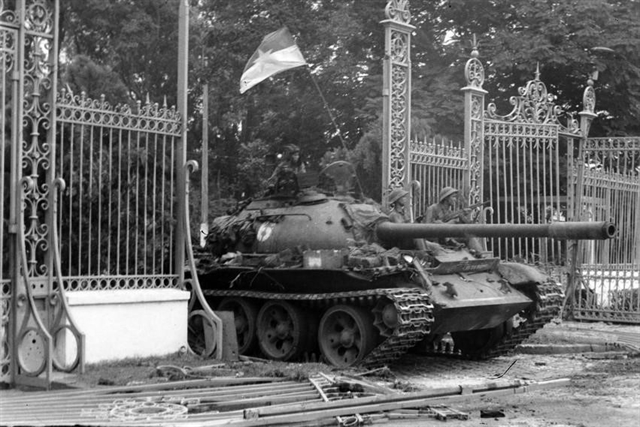 Society
Society

.jpeg) |
| Four members of the crew of Tank 843, who planted the flag on the roof of the Presidential Palace on April 30, 1975..— VNA/VNS Photo Quang Thành |
To mark the 45th anniversary of Việt Nam’s 1975 Great Spring Victory (April 30, 1975) and the fall of the America-backed Sài Gòn administration, ending the American War and leading to the liberation of southern Việt Nam, the Vietnam News Agency presents an article by Nguyễn Đinh Lê, PhD, a lecturer from the History Faculty of the University of Social Sciences and Humanities, Vietnam National University, Hà Nội.
In 1954, the French colonialists were defeated in the battle of the Điện Biên Phủ and were forced to sign the Geneva Agreement (July 1954) to withdraw from Indochina. However, shortly after, the United States stepped up to fill the vacuum, increasing military aid to South Việt Nam and sending the first US military advisers to the country in 1959 to implement its global anti-revolution policy. They did everything to suppress the South’s revolution.
From 1954 to 1958, South Việt Nam lost a huge number of officials and Party members. Nearly 90,000 patriots were arrested and imprisoned and nearly 20,000 were tortured and killed. The country was divided into two regions with two opposing regimes: the North, which was completely liberated, and the South, which was still under colonialism.
The Centre Party Committee’s Congress in 1960 outlined the path for the resistance war against the US, which was strengthening the solidarity of the people, maintaining peace and implementing the socialist revolution in the North and the national democratic revolution in the South.
Since 1965, to save the Sài Gòn regime, the US sent troops, troops of some allied countries, weapons, equipment and modern war vehicles to fight in the South and also waged a war of destruction by air and navy against North Việt Nam.
The 12th plenum of the 3rd Party Central Committee again affirmed that the duty to fight the US and save the country was a sacred duty of the whole nation. From then, there was a determination to mobilise the nation's forces to defeat US imperialism to protect the North, liberate the South and unify the country.
The resistance war strategy proposed by the Party met the earnest aspirations of the people of the whole country, and it had become a banner to lead the entire Party, the army and people to unite and utilise the country’s strengths to fulfil the revolutionary’s mission. Many patriotic emulation movements took place nationwide.
These movements typically involved donating food for the army, young people volunteering to do tasks assigned by the Party and the revolutionaries and women supporting their husbands on the frontlines while also taking care of their families back home.
Former US Defense Secretary Robert McNamara admitted that the US lost the battle because it underestimated the power of Vietnamese nationalism that motivated them to fight for noble values.
After nearly 20 years of constant struggle, the Vietnamese army and people gradually defeated the enemy's strategies: unilateral war, killing communists (1954 - 1960), special war (1961 - 1965), local war (1965 - 1968), and Vietnamisation of war (1969 - 1973), forcing the US to sign the Paris Agreement (1973) on ending the war, restoring peace in Việt Nam. The US also had to withdraw all expeditionary troops from Việt Nam. This was a basic victory and a turning point for Việt Nam.
Reunification
According to the peace agreement signed in Paris, the South Vietnamese administration was to remain in place until new elections were held, and North Vietnamese forces in the South were not to advance further nor be reinforced.
However, the US continued its assistance to the Sài Gòn regime, breaking the peace agreement and prolonging the war.
 |
| A North Vietnamese tank rolls through the gate of the Presidential Palace in Saigon, on April 30, 1975. — VNA/VNS Photo Trần Mai Hưởng |
By the end of 1974 and early 1975, the war had turned in favour of Việt Nam’s revolution. The Politburo decided to step up the military and politicial fight in combination with the fight on international relations to quickly and comprehensively change the situation in the South. These were considered as necessary preparations for the general attack to put the government in the hands of the people and liberate the South.
In the first three months of 1975, almost 12,000 officials and soldiers were brought to the battlefront, as well as more than 230,000 tonnes of necessities for war like weapons, oil and gas, medicine and food.
The assistance from the North to the South in this period not only created an overwhelming strength compared to the enemy, but also met the requirements of post-revolutionary tasks on economy, defence, culture, education, health.
With the great support of the North, throughout the battlefield in the South, our people and army prepared well for the final decisive battle.
After preparation in all aspects, on March 4, 1975, the general offensive and rebellion of our people and army began, taking place with three major strategic attacks: Central Highlands Campaign (March 4 to April 3, 1975), the liberation of Huế - Đà Nẵng (March 21 to March 29, 1975) and the Hồ Chí Minh Campaign (from April 26 to April 30, 1975).
At noon on April 30, 1975, our troops entered the Independence Palace, capturing the enemy central government cabinet. The Hồ Chí Minh campaign was successful, ending the resistance war against the US. This is one of the most glorious feats in the development process of the Vietnamese nation.
On the occasion of the whole country celebrating the 45th anniversary of the Great Spring Victory of 1975, we are more deeply aware of the significance of this great historical event. Each of us can thus raise our national pride, cherish peace, sovereignty and every inch of the sacred land of the Fatherland; strive to work harder, study harder and contribute to the sustainable development of the country for the goal of a wealthy, democratic, fair and civilised nation. — VNS




